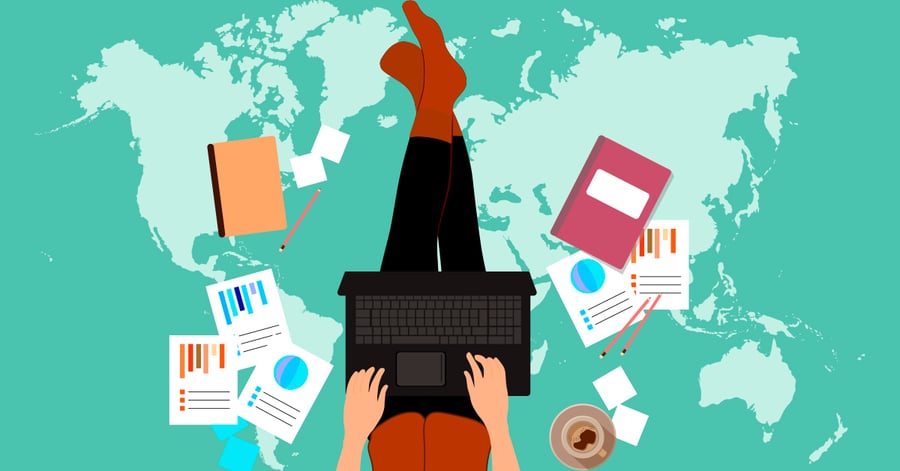
- Home
- Global Payroll
- Is work-from-anywhere here to stay?
Is work-from-anywhere here to stay?
Published :

Jenny, a software professional, is delighted with the new ‘work-from-anywhere’ policy introduced in her organization. She can now wake up at 8:50 AM for a 9:00 AM meeting and still not panic! Jenny can log on to her work system in pyjamas and start the meeting straightaway.
Furthermore, she need not worry about catching the bus or driving her vehicle through congested traffic. She does not have to commute to the workplace.
Jenny feels ecstatic working in this flexible model. There are no geographical or demographic barriers. She can choose to work from the office, home, coffee shops, gyms, salons, shopping malls, or anywhere in this world.
All Jenny requires is an uninterrupted internet connection. Jenny only needs access to her office intranet and can indeed work from anywhere!
It is not just Jenny, In a study by Forbes, it was found that 97% of employees don’t want to return to the office full-time and 74% of professionals expect remote work to become standard. So how can organizations make this model work?
The following factors are the standing pillars of work-from-anywhere. They have made the model a reality:
Swift advancement in digital technology
Easy availability of broadband connections and technological devices, such as laptops, tablets, and smartphones, at economical rates
User-friendly virtual communication platforms and tools that facilitate connecting with people across the globe
Increasing employee preferences on maintaining a work-life balance and cutting daily office expenses (travel, clothes, shoes, etc.)
By all means, work-from-home or remote working was the only possible course of action available with the employers and employees during the pandemic. The sudden lockdowns and their perpetual extensions made it a go-to solution to the prevailing predicament at that time. But what started as a makeshift arrangement is now a popular and favoured working style.
Several companies worldwide, such as Google, Adobe, HCL, are now adapting to the hybrid working model. The purpose is to address the prevalent crisis (contain the spread of coronavirus) and provide workplace flexibility to their employees owing to its manifold advantages. Companies are now redesigning their workplace models to derive synergies from this emerging trend.
The new flexible workplace trend will benefit different employees having distinct requirements. Some examples:

Here are some challenges work-from-anywhere poses.
When employees work from different foreign locations, companies face the challenges of complying with the following laws applicable in each country:
Work-from-anywhere increases the risks of cybersecurity breaches. Companies need to safeguard their confidential data from theft and unauthorized disclosures.
Driving employee engagement and productivity is challenging for a geographically-dispersed employee base.
For Employees
Conclusion
The work-from-anywhere trend is here to stay. Employers need to take the necessary measures to enable it better and ensure workforce satisfaction.
It is achievable when they take strategic steps, such as consulting key stakeholders for drafting global business expansion policies, identifying operational and statutory risks of international remote working and developing sustainable solutions to mitigate them.
Employers must also redesign policies on data-sharing, communication, and employee performance management and engagement. At the same time, they need to manage employee governance and statutory compliance on implementing workflows, getting approvals, and managing employer obligations.
Enterprise asset management (EAM) involves the management of mission critical assets of an organization throughout each asset's lifecycle. EAM is used to plan, optimize, execute, and track the needed maintenance activities with the associated priorities, skills, materials, tools, and information. The aim is to optimize the quality and utilization of assets throughout their lifecycle, increase productive uptime and reduce operational costs.
Enterprise asset management (EAM) involves the management of the maintenance of physical assets of an organization throughout each asset's lifecycle. EAM is used to plan, optimize, execute, and track the needed maintenance activities with the associated priorities, skills, materials, tools, and information.
The software helps in effective maintenance of assets through preventive, predictive, shutdown and breakdown maintenance strategies. The system also helps enterprises mitigate equipment risks by enhanced safety standards. The streamlined operations and improved asset performance helps organizations increase their investment effectiveness.
EAM is important because it helps organizations track, assess, manage and optimize asset quality and reliability. Asset intensive Organizations have hundreds, thousands, even millions of assets which needs to be maintained to maximize / optimize life of these assets to increase the return on investment.
The key features of effective EAM are:
Asset Intensive companies under the following Industries :
Contact us for a meeting and schedule a demo
This differs on case to case basis, based on the type of installation and unique industry specific requirements. Contact us for a meeting and schedule a demo.
This differs on case to case basis, based on the type of installation and unique industry specific requirements. Contact us for a meeting and schedule a demo.
Stay Connected, follow us on LinkedIn / Twitter to know more about EAM Software latest trends.

All Rights Reserved. © Copyright 2024. Ramco Systems.